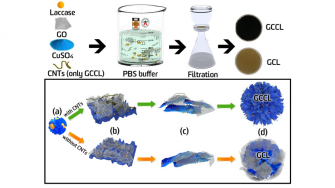

Self-assembly of a nanoflower with high surface area
A bio-inspired approach for the synthesis of flower-like copper phosphate crystals was proposed in this study. Herein, polydopamine (PDA) was applied to result in the self-assembly of crystals. The flower-like copper phosphate, composed of individual copper phosphate crystals possess self-assembled flowerlike architectures. The flower-like copper phosphate had a specific surface area of 1646.4 m2/g, much higher than irregular copper phosphate crystals of 245.3 m2/g. This method is expected to have many potential applications including catalysis science, antibacterial materials, and biological research.

SEM images of the nanoflower

Formation of PDA/Cu3(PO4)2·3H2O. a) Proposed mechanism, comprising four steps. Gray spheres indicate PDA molecules. Blue spheres indicate copper ions. Blue petals indicate the crystals of Cu3(PO4)2·3H2O. Step 1: PDA form complexes with copper ions; Step 2: forming small agglomerates with primary crystals; Step 3: PDA bonding with primary agglomerates; Step 4: continuous growth. b) fledglingPDA/Cu3(PO4)2·3H2O flowers (concentration of dopamine: 3 mg/L); c) grown PDA/Cu3(PO4)2·3H2O nanoflowers (the concentration of dopamine: 30 mg/L).
- Research team
- Collaborators
- Publications
Prof. Yatao Zhang
Duan, L., Wang, H., Hou, J., Zhang, Y. and Chen, V., 2015. A facile, bio-inspired synthetic route toward flower-like copper phosphate crystals with high specific surface area. Materials Letters, 161, pp.601-604.
